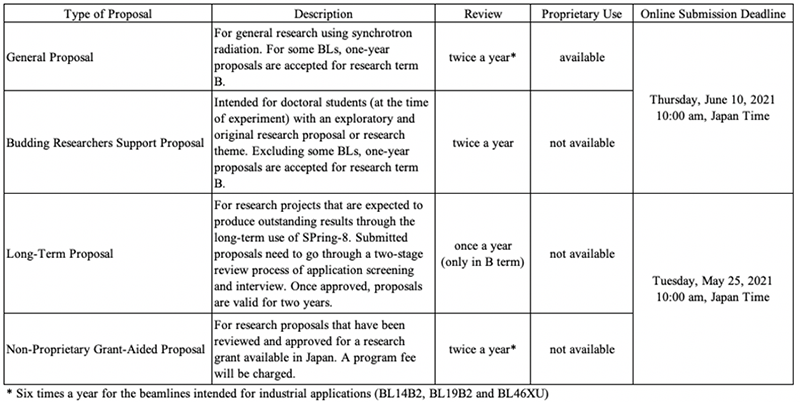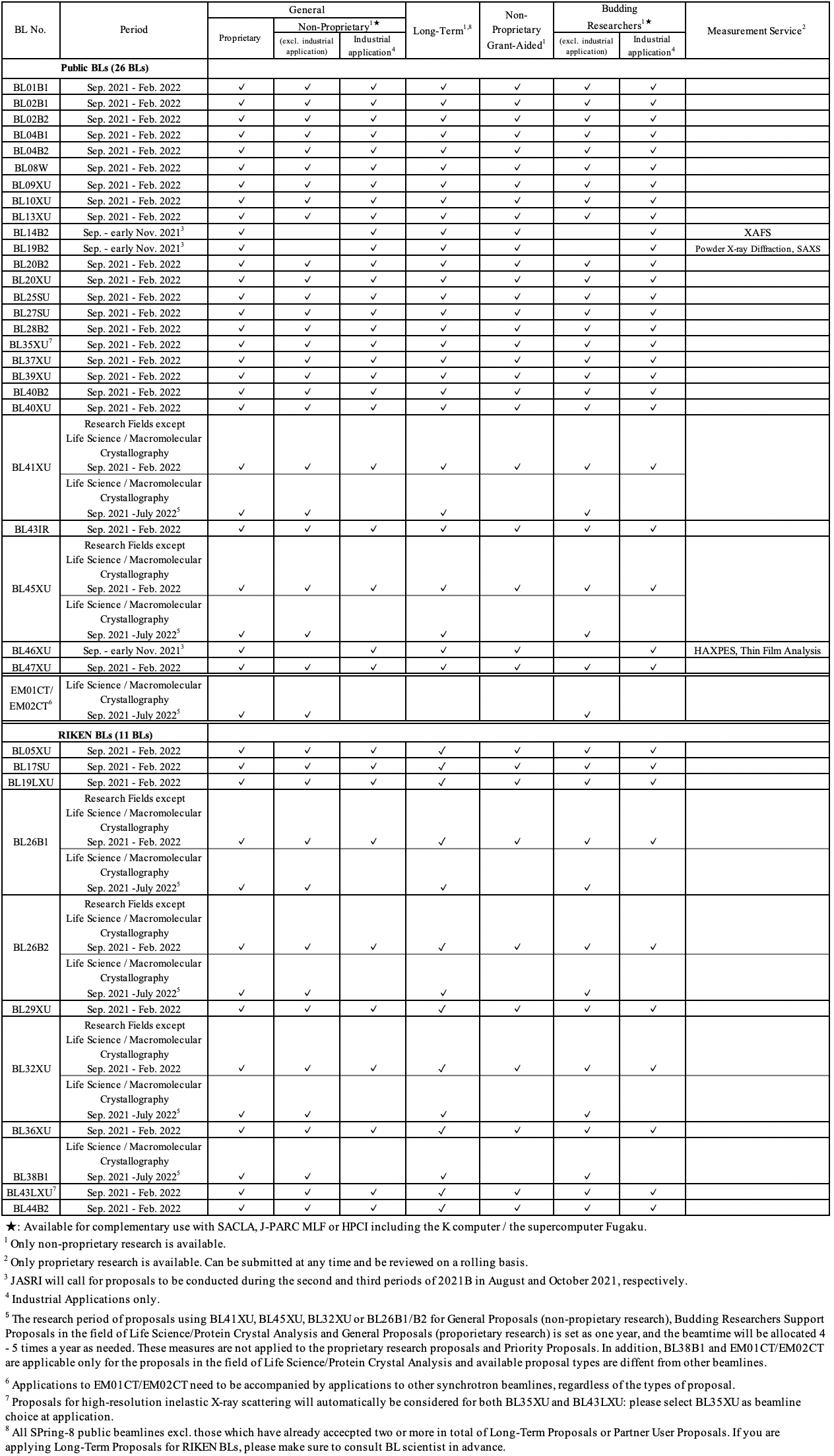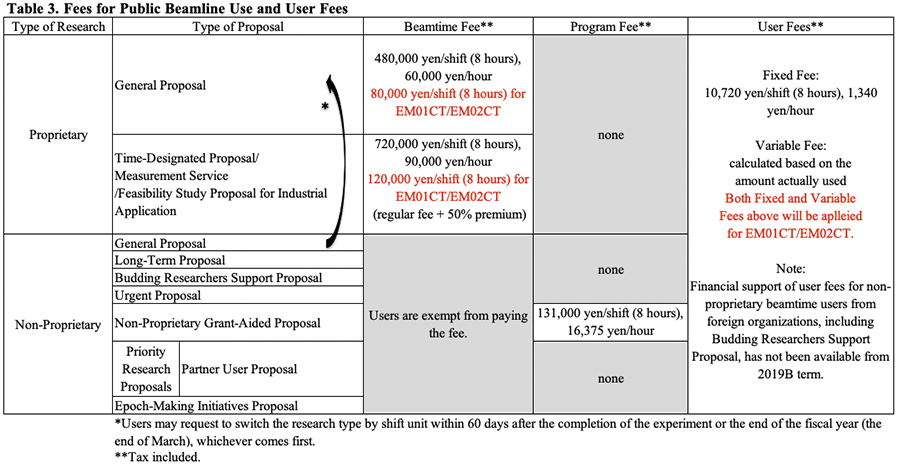Call for 2021B SPring-8 Research Proposals – Overview –
Special Notes on COVID-19
The same policy that was applied to 2021A proposals will be applied again to 2021B term in order to minimize the effects of beamtime cancellations due to COVID-19. Please make sure to check here.
Important
- Please understand that there is a possibility that we cannot provide stable supply of Helium (both liquid and gas) due to the recent situation regarding global helium supply.
[Contents]
- 2021B User Operation
- 1.1 Beamtime Available to Users in 2021B: 270 shifts (tentative)
- 1.2 Types of Research and Proposals Available for 2021B Beamtime and Submission Deadline for Online Proposals (Japan Time)
- General, Budding Researchers Support: June 10, 2021, 10:00 am
- Non-Proprietary Grant-Aided Proposals, Long-Term Proposals: May 25 2021, 10:00 am
- 1.3 Beamlines Available for 2021B Public Beamtime
- 1.4 Several Bunch Mode Operation in 2021B
- 1.5 Complementary Use with SACLA, J-PARC MLF or HPCI including the K computer / the supercomputer Fugaku
- 1.6 Trial Operation of Public Uses of CryoTEMs
- 1.7 Changes in Operation of Proposals at BL38B1
- 1.8 Changes of Measurement Methods at Public BLs
- 1.9 Mechanical failure of Insertion Devices at BL17SU
- 1.10 Beamtime Allocation at BL09XU and BL13XU
- Requirements
- 2.1 User Registration
- 2.2 Application for Beamtime
- 2.3 Radiation Worker Registration
- 2.4 Others
- Fees (Tax Included)
- List of Beamline Summaries
- Contact
1. 2021B User Operation
1.1 Beamtime Available to Users: 270 shifts (tentative)
270 beamtime shifts will be available for 2021B (from September 2021 to February 2022) .
1.2 Types of Research and Proposals Available for 2021B Beamtime and Online Submission Deadline for Online Proposals (Japan Time)
[Types of Research]
There are two types of research available at SPring-8: proprietary and non-proprietary research. Users are exempt from paying the beamtime fee if their research is non-proprietary. For research to be considered non-proprietary, users are required to make their research results available to the public through refereed journals or equivalent. For proprietary research, the research proposals are reviewed only from the viewpoint of feasibility, safety, sociality, and ethics. In this type of research, users are charged a beamtime fee of 480,000 yen/shift based on cost recovery for SPring-8 beamline operation. In return, users are not required to make their research results publicly available.
If you are a doctoral student (at the time of experiment) and wish to apply for beamtime (submit a proposal as a project leader), the budding researchers support proposal is your only choice; as a project team member, you can participate in any research project.
[Types of Proposals Available for 2021B Beamtime and Submission Deadlines (Japan Time)]
Click on the link to see the call for proposals.
- – General Proposals: June 10, 2021, 10:00 am
- A signed PDF file of Proprietary Use Agreement for Public Beamline (proprietary research only) must be received by email before June 17, 2021.
- – Budding Researchers Support Proposals: June 10, 2021, 10:00 am
- A signed Agreement must be received by email before June 17, 2021.
- – Non-Proprietary Grant-Aided Proposals: May 25, 2021, 10:00 am
- A signed SPring-8 Program Fee Payment Agreement/Confirmation Check Sheet and research purpose/plan must be received by email before June 1, 2021.
- – Long-Term Proposals: May 25, 2021, 10:00 am
- A-mode: 203 bunches
- B-mode: 4-bunch train x 84
- C-mode: 11-bunch train x 29
- F-mode*:1/14-filling + 12 bunches
- G-mode*:4/58-filling + 53 bunches
- H-mode: 406 × 11/29−bunches + 1 bunch
- [Available Types of Proposals]
- General Proposals (non-proprietary only)
- Budding Researchers Support Proposals
- [Beamlines Available to the Program]
Click here to see the list of beamlines available to the program. Proposal Types marked with ★ are available. - – Safety Precaution
For your safety, do not work alone. Please include the name of your project team members in the online proposal application and make sure to work in a group of two or more. - – Cancellation of Beamtime
Please be advised that your scheduled beamtime may be cancelled in case of emergencies such as equipment failure, natural disaster, and pandemic. In such cases, users cannot claim compensation for the lost beamtime. - – General Insurance and Compensation
Users shall take out appropriate personal injury and liability insurance before conducting experiments. If their project teams include students, they shall make sure that all the students take out appropriate personal injury and liability insurance. If users damage SPring-8 facilities, equipment or persons, either willfully or through gross negligence, JASRI may require them to meet all or part of the cost of repairs. JASRI shall take due account of all relevant circumstances in determining the degree of user liability. - A variable fee will be calculated and added in accordance with the amount of liquid helium actually used.
Table1. Types of Proposals Available for 2021B Beamtime

1.3 Beamlines Available for 2021B Beamtime
Beamlines available for 2021B beamtime by type of proposal are listed below.
Table 2. Beamlines Available for 2021B Beamtime by Type of Proposal

For the specifications and status of experimental stations, please check the Beamline List and Table4. List of Beamline Summaries.
1.4 Several Bunch Mode Operation in 2021B
The several bunch modes scheduled for 2021B are as follows:
Please note that there may be a possibility that the operation in above Bunch Mode cannot be provided depending on the Accelerator Status.
* The filling modes of F- and G-modes are operated only in research term B (e.g. 2021B, 2022B). In research term A (e.g. 2022A, 2023A), the D-mode (1/7-filling + 5 bunches) and the E-mode (2/29-filling + 26 bunches) will be operated instead of the F- and G-modes. For details, click here.
If you have a preference for a particular operating mode, choose from the pull-down menu on the Basic Information page of the online application form, and explain the difference in efficiency between your first- and other modes in the box provided for “Others.”
1.5 Complementary Use with SACLA, J-PARC MLF or HPCI including the K computer / the supercomputer Fugaku
To encourage research that is expected to produce excellent results more effectively through complementary use with J-PARC MLF (neutron facility) or HPCI including the K computer / the supercomputer Fugaku (public computational resource of High Performance Computing Infrastructure including the K computer / the supercomputer Fugaku) rather than when SPring-8 is used alone, we have been inviting SPring-8 proposals for such complementary use with either or both facilities since 2014A. SACLA has been added to those facilities for complementary use from 2017A. Available types of proposals and beamlines are as follows:
For details, please refer to the “Call for 2021B SPring-8 Research Proposals for Complementary Use with SACLA, J-PARC MLF or HPCI including the K computer / the supercomputer Fugaku“.
1.6 Trial Operation of Public Uses of CryoTEMs
Since the 2021B term, two CryoTEMs will be available for public use as an ancillary facility for PX-BL beamlines. If you are interested, please see CryoTEMs for public use at SPring-8.
・EM01CT : CRYO ARM 300 (K3 detector)
・EM02CT : CRYO ARM 200 (K2 detector)
1.7 Changes in Operation of Proposals at BL38B1
BL38B1, RIKEN Structural Biology I beamline, will be added to Macromolecular Crystallography Beamlines (PX-BLs) from 2021B term. Please note that BL38B1 is available only for BioSAXS experiments. Please refer to 2021B Operation of Proposals in the field of Life Science/Protein Crystal Analysis for details.
1.8 Changes of Measurement Methods at Public BLs
Due to the upgrade works at the public beamlines, the measurement methods for the following three beamlines will be changed as follows:
BL09XU:HAXPES (Nuclear Resonance Scattering will be transferred to BL35XU)
BL35XU:Inelastic and Nuclear Resonant Scattering (Nuclear Resonance Scattering will be transferred from BL09XU)
BL47XU:Micro-CT (HAXPES will be transferred to BL09XU)
1.9 Mechanical failure of Insertion Devices at BL17SU
Due to the mechanical failure of the insertion device of BL17SU, the light polarization and energy range available are currently restricted to vertical polarization and 480-2,000 eV, respectively (circular polarization is not available). Please contact SPring-8 Users Office for details.
1.10 Beamtime Allocation at BL09XU and BL13XU
Due to the commissioning HAXPES equipment at BL09XU, 2 weeks (42 shifts) at the beginning of 2021B term is not available for users.
Beamtime allocation for experiment using Ultra-high vacuum (UHV) chamber (Hutch 3) and Microdiffraction system (Hutch 4) at BL13XU will be scheduled for the period between September to December 2021.
2. Requirements
2.1 User Registration (Not Required of Repeat Users)
To submit an application online, you must have obtained a user account (user card ID number and password) by registering yourself. Please make sure that not only project leaders/applicants but also all project team members are registered as SPring-8 users. If you are not registered as a SPring-8 user, click here to register.
Note: Registration information is also used for contact. If any of your registration information changes, you must update it from the UI site.
Front Page > Log in to My Page > Search/Other > Edit My Details
2.2 Application for Beamtime
Applicants/project leaders are required to submit proposals online from the User Information website (UI site) through the web-based proposal submission system.
Log in to the system with your user card ID number and password. If you have not obtained your user card ID number, please complete user registration first. Please note that only the project leaders can submit proposals. Before starting the application process, project leaders must make sure that all project team members have completed user registration.
To avoid losing work in the event of a browser crash or unexpected logout, you are strongly encouraged to first draft your application offline using the MS Word template available from here.
For step-by-step instructions on how to submit proposals, click here.
[Important Notes]
a. Project Leader
A project leader is the person who will have overall responsibility throughout the experiment at SPring-8. The project leader and the person who is responsible for the research may not be the same person. Likewise, the project leader need not be the first author for SPring-8-related publications.
b. Application Type (New/One-Year (accepted for B terms only))
If you wish to apply for a one-year proposal, which (a) is applicable only for non-proprietary General Proposals with use of certain limited BLs and Budding Researchers Support Proposals, (b) may allow you to use beamtime in two consecutive research terms (starting at B terms and ending at A terms), and (c) is applicable only in B terms (no call for A terms), choose One-Year as Application Type.
c. Use of Multiple Beamlines
Applicants wishing to use more than one beamline must submit a separate application for each beamline. Submitting multiple applications is not detrimental to applicants if it is deemed appropriate to use more than one beamline. In such a case, applicants may use the same wording in the abstract page of the applications.
d. Number of Shifts Required (8 h/shift)
Generally, beamtime is allocated in increments of 3 shifts, however, the minimum allocatable beamtime is 0.25 shift for BL41XU and BL45XU, 1 shift for BL26B1/B2, and 1.5 shifts (or 0.25 shifts for Automatic Data Collection without visit) for BL32XU. Similarly, the minimum allocatable beamtime is 3 shifts for EM01CT/EM02CT. If you need assistance in calculating how many shifts are necessary for your research, please contact the Beamline Scientist.
e. List of SPring-8 Publications (Repeat Users Only)
Please be sure to provide the list of publications with brief descriptions in chronological order with the most recent first. List as many as space permits.
f. High Pressure Gas Cylinder
If you wish to bring in a high-pressure gas cylinder, please make sure to provide all required information in the online application:
[Known Safety Hazards & Measures to Be Taken]
“Does your proposed research involve any of the following?” > Check the box for “High pressure gas cylinder.” Then, fill out the “Details of samples” table properly. Please be advised that if you attempt to bring in a high-pressure gas cylinder without providing the required information in the application, there may be restrictions on the cylinder to be brought into the site during the administrative procedures required by the High Pressure Gas Safety Act.
g. Mode Operation
For details on options for Mode Operations, please click here.
2.3 Radiation Worker Registration
Japanese Law (Ordinance on Prevention of Ionizing Radiation Hazards) requires SPring-8 users, excluding non-visiting users using Measurement Service/PX-BL Automatic Data Collection, to be registered as SPring-8 radiation workers. To complete your registration, you must submit a “Radiation Worker Registration Form (Form 5-1)” by post at least 10 days before your visit. Once registered, submission of this form is not required for return visits within the same fiscal year (from April 1 to March 31 of the following year). For details, click here.
2.4 Others
3. Fees (Tax Included)
Fees for public beamline use and user fees are summarized in the Table 3. Fees for Public Beamline Use & User Fees.

3.1 Beamtime Fee
[Non-proprietary Research]
| Type of fee | Per shift* |
| Beamtime fee | Users are exempt from paying the fee |
For research to be considered non-proprietary, users are required to disseminate their research results through refereed journals or equivalent and register the results with the SPring-8 Publications Database within three years from the end of the half-year research term. For details, click here.
[Proprietary Research]
Regular Use
| Type of fee | Per shift* |
| Beamtime fee | 480,000 yen |
Time-Designated Use
| Type of fee | Per shift* |
| Beamtime fee + 50% premium | 720,000 yen |
N.B. In 2021B term, beamtime Fees of EM01CT/EM02CT for regular and time-designated use are 80,000 yen/shift (8 hours) and 120,000 yen/shift (8 hours), respectively.
3.2 Program Fee for Non-Proprietary Grant-Aided Proposal
Intended for non-proprietary research projects that have been reviewed and approved for a large research grant, non-proprietary grant-aided proposals are exempt from scientific review, and only the technical feasibility and the safety of the experiment, the degree of expectation to produce results and ethics (e.g. exclusively for peaceful purposes) are reviewed and are available on the payment of program fee.
For any proposals that are allocated by the hour, the beamtime fee is charged by the hour.
| Type of fee | Per shift* |
| Program fee for non-proprietary Priority proposal | 131,000 yen |
3.3 User Fees
Public beamline users, including EM01CT/EM02CT users, are required to pay the fees to cover the costs of beamline maintenance/operation and consumables actually used (user fees). User fees are composed of a fixed fee charged for wear and tear on the facility and a variable fee charged for liquid He.
Fixed Fee
| Type of fee | Per shift* |
| User fee (fixed) | 10,720 yen |
Variable Fee
* 1 shift is 8 hours and for any proposals that are allocated by the hour, the fees are charged by the hour.
Important: Please note that financial support of user fees for non-proprietary beamtime users from foreign organizations has not been available from 2019B term. Similarly, domestic travel, lodging expenses and user fees support has not been available for Budding Researchers Support Proposal from foreign organizations. These expenses and fees have to be borne by the users themselves. We will cover the costs for Budding Researchers Support Proposals from domestic universities within the limit of the budget. Please note that the variable fee is not always covered when it exceeds the limit of the budget.
Click here for more details.
4. List of Beamline Summaries
Research areas and experimental stations/facilities available to users at each beamline are listed below. For the specifications and status of experimental stations, please also refer to the Beamline List. If you have questions, please contact the Beamline Scientist.
Table 4. List of Beamline Summaries
5. Contact
| Contact | Phone | E-mail address |
| SPring-8/SACLA Users Office, JASRI | +81-791-58-0961 | sp8jasri@spring8.or.jp |

